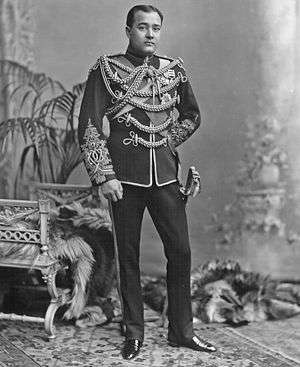Nripendra Narayan

Nripendra Narayan (Bengali: নৃপেন্দ্র নারায়ন) (4 October 1862 – 18 September 1911) was Maharaja of the princely state of Koch Bihar, India from 1863 till 1911.[1][2]
Early life
Nripendra Narayan was only ten months old when his father Narendra Narayan died in 1863. He was crowned as the king in the same year. Since he was still an infant the administration was handed over to the Commissioner appointed by the British Governor General.[3]
He studied at Wards Institute at Benaras, thereafter, at Bankipur College, Patna and lastly law at Presidency College, Calcutta. In 1878 he married Suniti Devi, a daughter of Keshab Chandra Sen of Calcutta. Immediately after marriage he left for England for higher studies.[3]

Family
He was the father of four sons and three daughters namely – Rajendra Narayan, Jitendra Narayan, Victor Nityendra Narayan, Hitendra Narayan and daughters Pratibha Devi, Sudhira Devi and Sukriti Devi. [4][5] Of his sons Rajendra Narayan and Jitendra Narayan later became the Maharajas of Cooch Behar. Gayatri Devi and Ila Devi were daughters of his son Jitendra Narayan.
Death
Nripendra died at the English coastal resort of Bexhill-on-Sea in September 1911. His funeral took place in Bexhill on 21 September 1911. The Maharajah had come to Bexhill to convalesce after leaving Moor Hall, Ninfield. One of his daughters had recently drowned. A memorial drinking fountain dedicated to Nripendra was opened by his second son, Maharaja Kumar Jitendra on 18 September 1913 (jitendra has just succeeded to the throne of Cooch Behar after the death of his older brother Rajendra). The fountain originally stood to the side of the Coastguards Cottages on the present site of the De La Warr Pavilion. When the cottages were demolished in 1934 to make way for the Pavilion, the fountain was re-erected in Egerton Park. It stood near to the park entrance next to the Bexhill Museum until 1963 when it was removed for restoration. It was stored in Bexhill Cemetery for a while but then subsequently disappeared. Its current whereabouts is unknown.[6]
Bexhill-on-Sea's historical society has produced a booklet "Bexhill's maharajah" summarising Nripendra's connections with Bexhill.
Work
.jpg)
He banned the practice of slave-keeping (Kritadas Pratha) in his State by introducing a law in 1884. In the year 1888, for the betterment of higher studies in his own state, he established the Victoria College now known as A.B.N. Seal College. Further, in the name of his queen, Suniti Devi, he set up a girls school called Suniti College in 1881 which was later named Suniti Academy. In 1883 he constructed the Nripendra Narayan Hall in Jalpaiguri city and in 1887 granted land for the construction of the Lewis Jubilee Sanitarium in Darjeeling.[4] He also established the India Club at Calcutta in 1882.[7] He also established the Anandamayi Dharmasala for distribution of free foods for poor at Cooch Behar in 1889. He founded in Cooch Behar, the botanical garden – Narendra Narayan Park in 1892.[8] He was also the first president of Calcutta Club founded in 1907.
References
- The Maharajah of Cooch Behar; Thirty-Seven Years of Big Game Shooting in Cooch Behar, the Duars, and Assam. Bombay, The Times Press, 1908.
Titles and styles
Titles
1887 – Grand Commander of Most Eminent Order of the Empire of India on the occasion of his attending the jubilee celebration of Queen Victoria.
Full style
Lieutenant-Colonel His Highness Maharaja Sir Nripendra Narayan Bhup Bahadur, GCIE, CB
Honours
- Empress of India Medal Gold-1877 with a Sword.
- Knight Grand Commander of the Order of the Indian Empire (GCIE)-1887
- Queen Victoria Golden Jubilee Medal-1887[9]
- Queen Victoria Diamond Jubilee Medal Clasp-1897
- Delhi Durbar Gold Medal-1903
Memorials
The Nripendra Narayan Memorial High School is named after him, which was founded by his son, Maharaja Jitendra Narayan in his memory in 1916.
Notes
- ↑ Lord Curzon & The Indian States 1899–1905 By Ikram Ahmed Butt. 2006. p. 333.
- ↑ COOCH BEHAR (Princely State), iinet.net.au
- 1 2 Encyclopaedia Indica: India, Pakistan, Bangladesh: Volume 100
- 1 2 Royal History, Shri. Hemanta Kumar Rai Barma, CHAPTER 6, "Kochbiharer Itihas", 2nd edition (1988), National Informatics Centre, Cooch Behar District, http://coochbehar.nic.in
- ↑ Profile, Suniti Devi (Sen), (1864–1932), geni.com
- ↑ http://publicsculpturesofsussex.co.uk/object?id=156
- ↑ The Golden Book of India: A Genealogical and Biographical by Sir Roper Lethbridge – 2005 pp 269
- ↑ A Directory of Botanic Gardens and Parks in India by R. K. Chakraverty, D. P. Mukhopadhyay – 1990 – Page 31
- ↑ Queen Victoria's Golden Jubilee
| Political offices | ||
|---|---|---|
| Preceded by Maharaja Narendra Narayan Bhup Bahadur |
Maharaja of Cooch Behar 1863–1911 |
Succeeded by Maharaja Rajendra Narayan II |